日本千叶地区学校自主活动旅行的关键因素:关注犯罪安全和社区倡议
IF 5.7
2区 工程技术
Q1 TRANSPORTATION
引用次数: 0
摘要
积极的学校旅行,以及它的独立性,对儿童的生理和心理发展至关重要。尽管有充分证明的好处,但在许多国家,儿童独立和积极的学校旅行正在减少,主要是由于家长对安全的担忧。以往的研究往往分别探讨学校旅行中的主动性和独立性维度,而本研究同时考察了这些相互关联的行为。它着重于识别环境因素——尤其是那些与犯罪安全相关的因素——这些因素会影响四种不同的学校出行习惯:独立活跃、独立不活跃、依赖活跃和依赖不活跃。2020年11月,在日本千叶县以小学生家长为对象进行了在线调查。对1452个有效回复进行了多项逻辑回归,以检验社会人口特征、社会和建筑环境变量之间的关系,以及潜在的互动因素,在日本,这种做法仍然很普遍。结果显示,大多数儿童(79.2%)独立步行上学,性别差异可以忽略不计。较高的犯罪安全感知与独立主动学校旅行呈正相关,社区监督地区的儿童更有可能独立旅行。虽然被调查者对预防犯罪活动的参与与学校旅行常规没有直接关系,但它显著调节了犯罪安全感知与自主主动上学旅行之间的关系。在父母对安全的看法不太有利的贫困地区,他们的自愿参与可以促进儿童推荐的旅程。这些发现强调了犯罪安全的关键作用,包括父母的主观看法和社区监督的客观存在,在促进自主积极的学校旅行中。本文强调了在日本维持和扩大这些举措的重要性,为儿童创造安全的通勤环境,同时在一个支持性的、儿童友好的环境中培养他们的独立性和积极发展。本文章由计算机程序翻译,如有差异,请以英文原文为准。
Key factors of independent active school travel in Chiba, Japan: Focusing on crime safety and community initiatives
Active school travel, as well as its independence, is crucial for children’s physiological and psychological development. Despite the well-documented benefits, children’s independent and active school travel is declining in many countries, largely due to parental safety concerns. While previous studies often explore the dimensions of activeness and independence in school travel separately, this research examines these interconnected behaviors in parallel. It focuses on identifying environmental factors—particularly those related to crime safety—that influence four distinct school travel routines: independent active, independent inactive, dependent active, and dependent inactive. In November 2020, an online survey was conducted targeting parents of elementary school children in Chiba, Japan. A multinomial logistic regression was performed with 1,452 valid responses to examine the relationships between the sociodemographic characteristics, social and built environment variables, as well as the potential interactive factor, on independent active school travel in Japan, where this practice remains common. The results showed that most children (79.2%) walked to school independently, with negligible gender-based disparities. Higher perceived safety from crime was positively associated with independent active school travel, and children in areas with community-based supervision were more likely to travel independently. Although the respondents’ participation in crime prevention activities was not directly associated with the school travel routine, it significantly moderated the relationship between perceived crime safety and independent active travel to school. In disadvantaged areas where parental perceptions of safety were less favorable, their voluntary participation could facilitate children’s recommended journey. These findings underscore the pivotal role of crime safety, encompassing both subjective parental perceptions and objective presence of community-based supervision, in promoting independent active school travel. This paper emphasizes the importance of sustaining and expanding such initiatives across Japan to create safe commuting environments for children, while fostering their independence and active development within a supportive, child-friendly setting.
求助全文
通过发布文献求助,成功后即可免费获取论文全文。
去求助
来源期刊

Travel Behaviour and Society
TRANSPORTATION-
CiteScore
9.80
自引率
7.70%
发文量
109
期刊介绍:
Travel Behaviour and Society is an interdisciplinary journal publishing high-quality original papers which report leading edge research in theories, methodologies and applications concerning transportation issues and challenges which involve the social and spatial dimensions. In particular, it provides a discussion forum for major research in travel behaviour, transportation infrastructure, transportation and environmental issues, mobility and social sustainability, transportation geographic information systems (TGIS), transportation and quality of life, transportation data collection and analysis, etc.
 求助内容:
求助内容: 应助结果提醒方式:
应助结果提醒方式:


